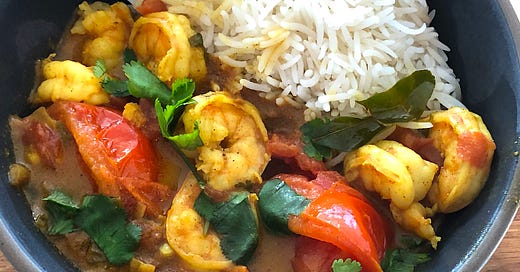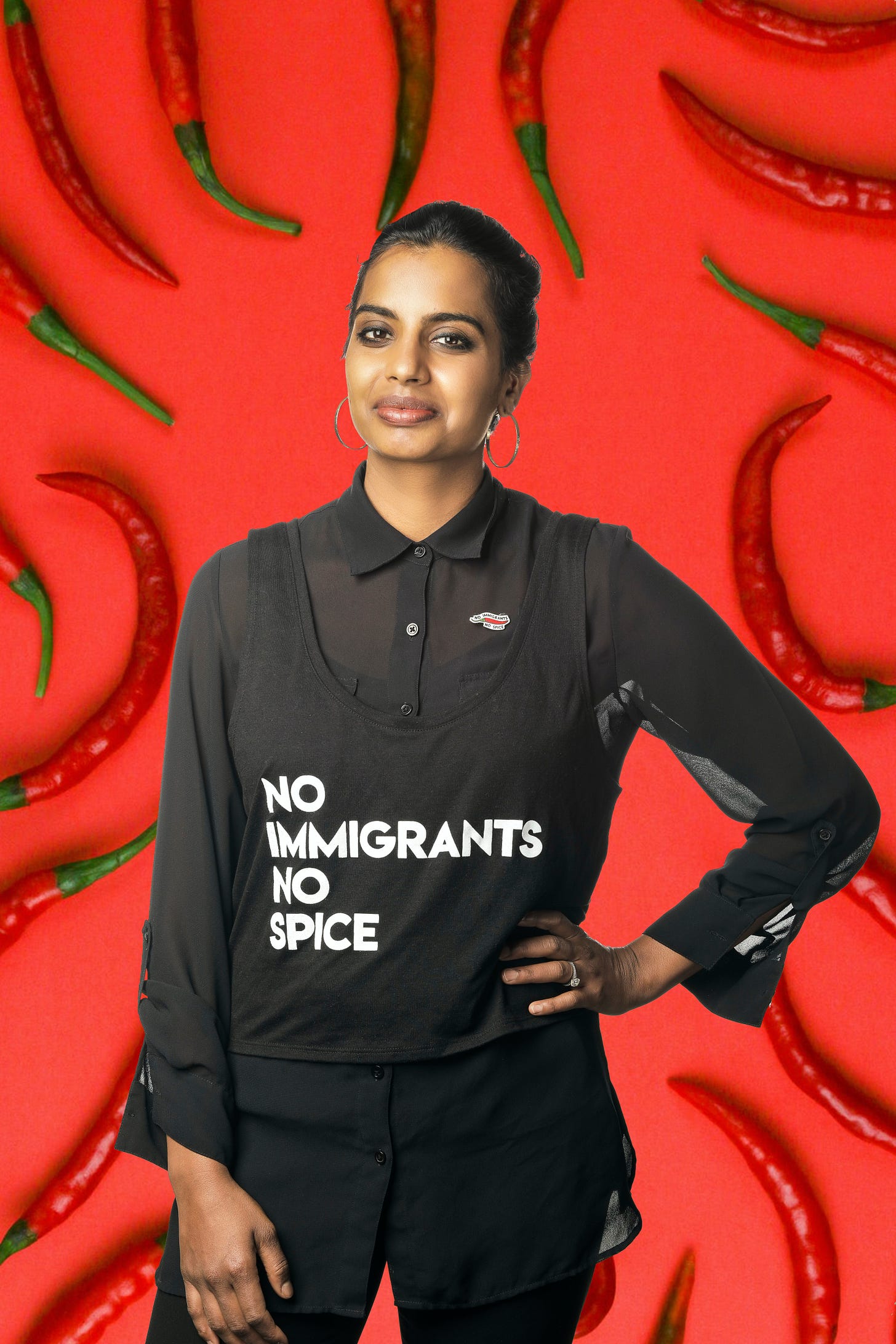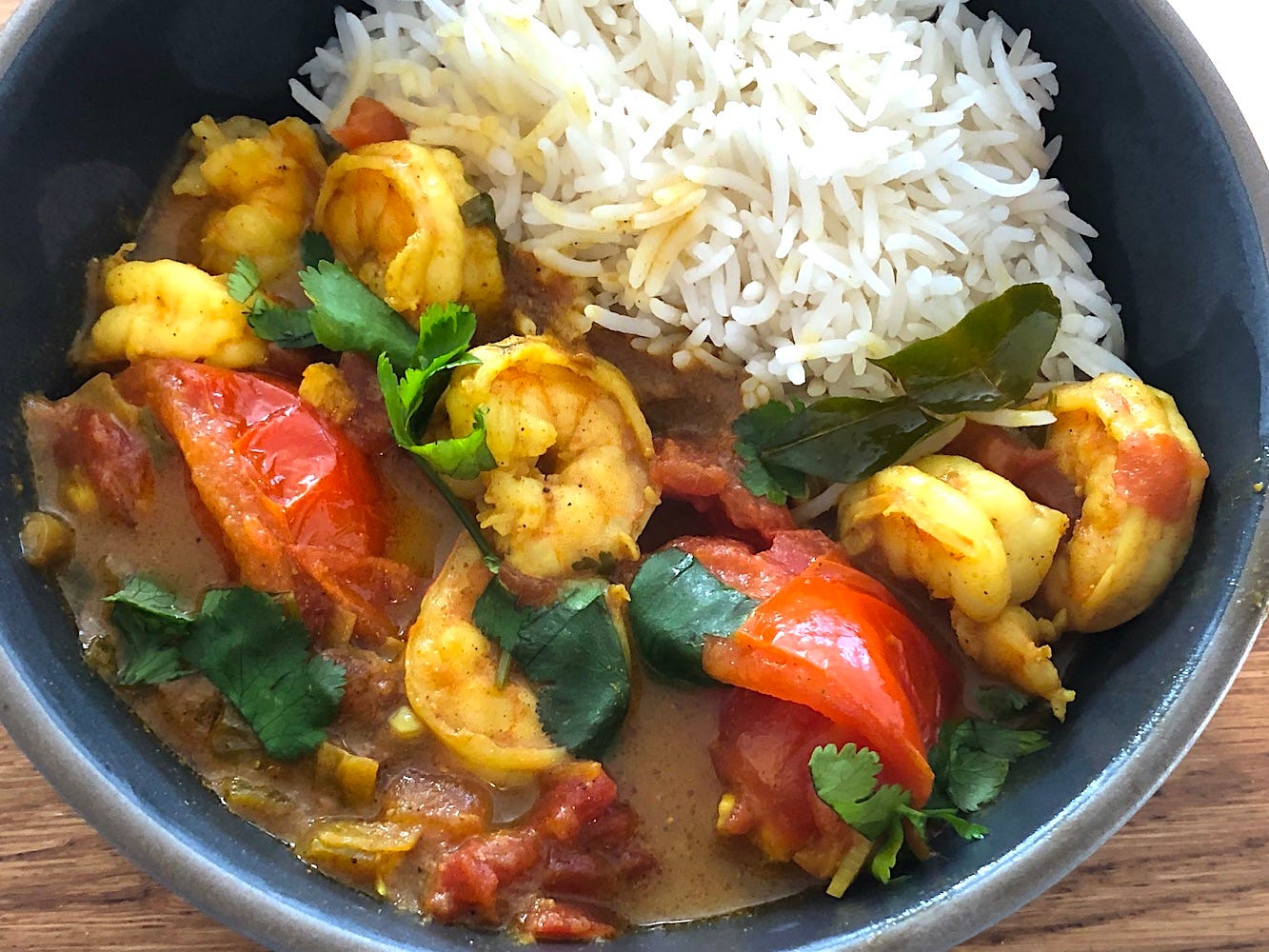Hello, lovely readers! This week I have the great pleasure of sharing an interview I did with Vibha Gupta, M.D. Vibha is the executive director and founder of No Immigrants No Spice (NINS)—a 501 C3 nonprofit focused on flipping the narrative on immigration where she works with chefs and immigrants from all over the world. She is also a doctor and the mother of a toddler. She was one of the first people I spoke with when I had the idea for the California Table back in 2020, and she connected me to many of the cooks I’ve interviewed previously, including Nafy Flatley and Candice and Jelmer.
The timing of this issue ended up working out perfectly, because NINS just announced a fantastic fundraiser called BBQ Without Borders. The event, which will take place on May 13th at the Oakland Museum of California, will feature three chefs—Lilly Duran of Clandestina Cocina, Ron Dumra of Wah Jee Wah, and Chef Tadayuki of the former Family Cafe—doing riffs on Cuban lechon, Indian tandoori, and Japanese yakitori. There will also be performances, including bhangra, taiko drummers, flamenco, Cuban salsa, and opera. If you’re in the Bay Area, grab tickets before they sell out and come join me there!
Vibha Gupta
I grew up in a small town called Okmos; it's basically a suburb of East Lansing, Michigan and kind of farmland area and college adjacent. I grew up with my parents and my sister, and, basically, my mom did all the cooking in the home.
My mom was born in Kenya, but she's Punjabi—she’s from North India. Her dad had migrated to Kenya and worked as an engineer there. But my mom grew up in Kenya for 14 years then lived in India briefly, for about four years, and then went to Canada and then the US. But I'd say she certainly identifies as a Punjabi woman.
When I was growing up, my poor mom did the thing where she made a meal for my dad and then a meal for me and my sister. She would make chicken curry and aloo gobi, which is a cauliflower-pea dish; mutter paneer, which is a cheese and pea dish; lots of naan. And she'd make handmade rotis. There was also always achar, either store-bought or homemade, in the house. If was usually pickled mango, but she also makes a pickled lime one that's really amazing. And lots of dal. And dal. She made tons of dals.
It was mostly Indian food, but then she also would do her own fusion nachos, enchiladas. She really gravitated towards Mexican-ish food because it was easier to give to us kids. And she liked it, too, because it was spicy. And then, you know, she would give us all the Hot Pockets and Bagel Bites that we would demand.
My dad’s meal was always chicken curry. I mean, to this day, I think he eats chicken curry every single day. There is sometimes a variation, but I can't even think of the last time he ate something besides chicken curry. She'll try to do different things, because she's quite an amazing cook and adventurous, but for him it was always chicken curry, roti, rice, maybe some sort of sabzi, which is a type of vegetables cooked down with lots of different types of spices that are Indian origin.
He did cook, but the only thing he ever cooked, every once in a while, was an egg curry—or he would do, like, smelt curry. That's the only thing I ever remember him making. Or he'd do Indian omelets in the morning, but then we'd be like, “There's too much spice in this.” It would be covered in cumin.
I did my training for emergency medicine in New York City, and then myself and my partner—now husband—ended up moving out here to California because we'd always wanted to and our jobs just aligned and it worked out. We always wanted to be in the Bay Area.
I only started cooking when I lived in the smallest apartment possible in the East Village in New York—with a very rudimentary stove. I think my friend Zoe—who's an extreme vegetarian in that like she was always proselytizing, We must eat vegetarian—she came over and was like, “I'm gonna teach you how to cook amazing vegetarian food.” So that's how it started, with like a red sauce, and “Here's how you boil pasta.” I'd say I really started cooking when I moved out here, where I had a bigger kitchen and access to fresh fruits and vegetables whenever I wanted them.
My cooking has been very self-taught. And whenever my mom comes out, we'll try to cook together. She’ll correct me. I'll make something, and she's like, “Uh-uh, not like this.” And then we'll redo it. And now whenever I go back to Michigan, I am just videotaping her and forcing her to make every dish. That’s kind of what our trips end up revolving around—trying to pass on these recipes. Like many parents who don't cook by recipes, she gets really annoyed when I'm like, “Well, how much do you put in this?” So, I try to cook with her as much as possible.
Interestingly, I went from being an extreme carnivore to, now, gravitating towards vegan and pescatarian dishes. Meat minimalist—someone told me that's what I am. Because I still eat it once in a while.
I make dal—like a moong ki dal, which is a larger yellow lentil dal. It’s simple; the secret ingredient is cinnamon. I make a Goan shrimp curry dish I love almost every week. We’ve been doing tofu banh mi sandwiches. They're so good. We do a lot of fish—just different preparations of salmon and tuna—and grilled vegetables. And we have a Big Green Egg my husband's obsessed with, so we make pizza on it and grilled eggplant, stuff like that.
My husband is actually a very good cook, but I don't give him enough credit. He’s from Missouri, so he liked meat-and-potatoes type stuff, but he is adapted really well to a vegetarian diet. Whenever there's something that needs to be grilled, he grills, and he usually does the fish. He's really good at that.
California has absolutely influenced my cooking. First of all, my grocery store is Berkeley Bowl West, which, arguably, is one of the best grocery stores that I've been to in the country in terms of the variety and the scale. And I go to Monterey Market.
For example, I love making tacos, and I love slicing kumquats and putting it on for that little bit of sweet and sour flavor. And that comes from like, just living in California. I had kumquats one day and I was like, Might as well just throw these on a taco.
The vegetables I can get here, they just taste better. Also, just the food scene here, is such a thriving scene, especially in the East Bay. Also, I just see vegan food everywhere here. Before, I had this mental block of, Oh, vegan food will be boring. But now I find that the most interesting food that I eat tends to be vegan or vegetarian because there's so much creativity with all these different places here. Like Lion Dance Cafe. It's so incredible, and it's totally vegan. It's definitely influenced my cooking. I try to replicate that stuff, even if I'm not doing it consciously.
I started No Immigrants, No Spice in 2019. It all kind of started after Trump was elected. I spent the first two years burying my head in the sand, and then I think I just got frustrated with my own apathy, and I got tired of seeing horrible things over and over again that were misrepresentations of immigrants in the media. I was just super angry.
And then I saw on Trevor Noah, a skit where he talked about, “If you hate immigrants, you’re not allowed to eat their food. All you’re allowed to eat is potatoes, without any salt. Because no immigrants, no spice.” And I was like, Whoa. That was a really succinct way to hit you in the gut and capture what I’m feeling. And that’s where it was born. I slapped “No Immigrants, No Spice” on a t-shirt and started selling it and sending the proceeds to Direct Legal Aid (Noah Trevor’s lawyers were fine with it), and then it just kind of evolved. I built my own website, started an Instagram, started giving talks and holding events, always highlighting food and finding commonality through food, whether that’s spotlighting chefs or just connecting with people in a real, tangible way at community gatherings. Now it’s this community platform, a space where people can come to us, and say “I can help,” or, “You should highlight this person,” or “You should look at the great work this person’s doing.
With the work I do with No Immigrants, No Spice, I also get to meet all these chefs, and it really plants these seeds for my cooking. For instance, I photographed this chef making this amazing Indonesian grilled fish platter, and I was like, Oh, maybe we could do this. I could get these ingredients at the store tomorrow, no problem.
Goan Shrimp Curry
This curry might look complicated with all its spices, but it’s actually a really easy meal to throw together, and it takes just about 30 minutes to cook once you’ve assembled all of your ingredients. If you start some basmati in a rice cooker, the curry should be ready by the time the rice is done. If you want to speed things up even more, you can start the onion, then gather and prep the remaining ingredients while it’s cooking.
One note about the spices: when Vibha showed me how to make this dish, she was working with old curry powder, and she had to add more to get the flavor she wanted. If your spices aren’t fresh, you might have to do the same!
Serves 4
3 tablespoons olive oil or avocado oil
1 medium white onion, diced
2 curry leaves
1½ tablespoons garam masala
1 tablespoon curry powder
1 tablespoon turmeric
1 teaspoon kosher salt
¼ - ½ teaspoon Indian chile powder
6 - 7 cloves garlic, roughly chopped
2 medium on-the-vine tomatoes, quartered
½ cup plus 1 tablespoon cilantro, roughly chopped
14 ounce can pureed tomato
14 ounce can full-fat coconut milk
1 lb. raw peeled shrimp
Heat a Dutch oven over medium heat. Add the oil and the onion, and cook, stirring occasionally, until they are golden and beginning to brown, about 10 minutes.
Add the curry leaves and the garam masala, curry powder, turmeric, salt, and chile powder to the pot. Toast the spices, stirring frequently, until very fragrant, about 1 minute.
Add the garlic and cook for 30 seconds, then add the tomato and 1 tablespoon of the cilantro. Pour in the pureed tomato and add 3½ water. Turn the heat up and bring the mixture to a low boil, then turn the heat to low and let the mixture cook for 5 minutes, to meld.
Use a spoon to add the fat from the can of coconut milk to the pot, then add all but about 2 tablespoons of the remaining liquid. Add the shrimp, bring the mixture to a simmer, and cook the shrimp for 5 minutes, until cooked through.
Serve the curry with rice and garnish with the remaining cilantro.
Photos: Georgia Freedman, Courtesy Vibha Gupta (4)









